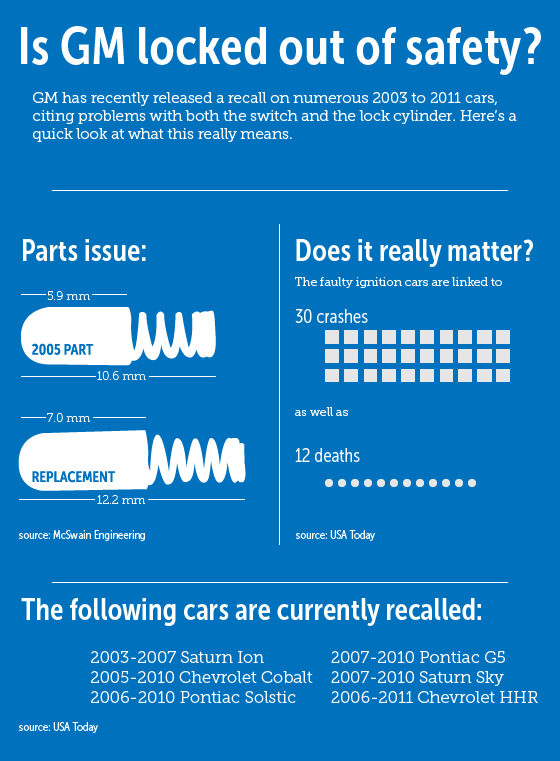Recalls continue to torment General Motors
May 21, 2014
On May 1 1919, workers at the first General Motors assembly plant in Janesville, Wis. rolled out their first tractor as part of the company’s then-active Samson Tractor Division. One world war and an economic depression later, the Janesville plant made the corporation’s one hundred millionth vehicle in April 1967, six million of which came from the plant itself.
Ten years afterwards, the plant employed 71 hundred people and had produced over 274 thousand cars and 114 thousand trucks. Total annual payroll was at $128.5 million.
After 32 years of alternating between growth and layoffs, the plant’s fate was sealed in October 2008 when GM announced that production at the nearly 90 year old plant would end in two months. It was only the beginning.
The situation became catastrophic in June, when GM announced plans to close 14 additional plants and cut close to 20 thousand jobs. Things were beginning to look grim.
Although the government would lose $11 billion in the end, a $50 billion bailout ($39 billion of which taxpayers footed) saved the company from going under in 2009. Afterward, GM showed signs of an unprecedented recovery. It appeared as though the behemoth automaker was bound for a major comeback. And up until last March, they were heading in the right direction.
According to Forbes, GM has spent $1.3 billion in expenses this year to pay for the 2.6 million vehicle recalls they were plagued with in March. The recalls were prompted by an overlooked fault in the ignition switch on various Pontiac, Saturn and Chevrolet models that has resulted in 31 crashes and 13 deaths from drivers suddenly losing control of their vehicles while driving.
In early May, GM announced an additional recall of 50 thousand luxury SUVs regarding a computer error that delays acceleration for three to four seconds, according to CBC News. Since February, GM has recalled close to seven million cars.
The shear disorganization of the company’s leadership and investigative ability manifested in early April when General Motors CEO Mary Barra was questioned before the House Energy and Commerce Subcommittee.
The primary concern on the subcommittee’s minds was an interesting piece of information disclosed in an official document submitted to them by government officials.
According to Mlive.com, the document revealed that GM had known about the ignition issue for close to ten years.
Even though Bara has only been GM’s CEO since January, she has been caught in the media’s crosshairs for not sufficiently addressing the causes of how this was overlooked. The real problem lies deeper within the company rather than in Barra’s leadership. The fact that it took GM ten years to act on the ignition issue should shed some light on the flaws embedded deep within its corporate structure.
A mass reorganization of the company’s managerial framework would do GM well if they truly wish to work out these outstanding corporate flaws. That is, assuming they could afford such a costly operation.
The New York Times reported that GM’s first quarter earnings fell sharply due to the $1.3 billion price tag amassed from recalls. At this time last year, GM’s net income was $865 million. This year, it’s $125 million.
The federal government and US taxpayers did not pay for GM to continue in its blatant disregard for quality and safety. If GM really does care about the consumer, it will reorganize the glitches in its corporate model and prove that it was a $50.1 billion well spent.







